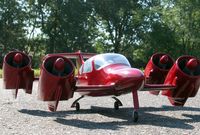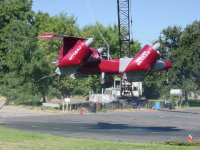I have been following this for over 10 years now and progress, although slow, is being made. I believe this will be the closet thing I see to having a flying car in my lifetime.
The Moller Skycar is a prototype personal VTOL (vertical take-off and landing) aircraft — a “flying car” — called a “volantor” by its inventor Paul Moller, who has been attempting to develop such vehicles for many years.1 The Skycar demonstrated limited tethered flight capability in 2003. More tethered flight tests are now scheduled for an undisclosed date sometime after mid 2006. Moller is currently upgrading the Skycar’s engines, and the improved prototype is now called the “M400X”.
 Given the machine’s very protracted development and its ambitiousness, skepticism that the machine will work as claimed remains high. In 2003, the Securities and Exchange Commission sued Moller for civil fraud (Securities And Exchange Commission v. Moller International, Inc., and Paul S. Moller, Defendants) in connection with the sale of unregistered stock, and for making unsubstantiated claims about the performance of the Skycar. Moller settled this lawsuit by agreeing to a permanent injunction and paying $50,000. In the words of the SEC complaint, “As of late 2002, MI’s approximately 40 years’ of development has resulted in a prototype Skycar capable of hovering about fifteen feet above the ground.”
Given the machine’s very protracted development and its ambitiousness, skepticism that the machine will work as claimed remains high. In 2003, the Securities and Exchange Commission sued Moller for civil fraud (Securities And Exchange Commission v. Moller International, Inc., and Paul S. Moller, Defendants) in connection with the sale of unregistered stock, and for making unsubstantiated claims about the performance of the Skycar. Moller settled this lawsuit by agreeing to a permanent injunction and paying $50,000. In the words of the SEC complaint, “As of late 2002, MI’s approximately 40 years’ of development has resulted in a prototype Skycar capable of hovering about fifteen feet above the ground.”
The craft currently under development, the M400, is intended to ultimately transport four people. It is described as a car since it is aimed at being a popular means of transport for anyone who can drive, incorporating automated flight controls. The driver should only input direction and speed, no pilot knowledge being required.
Also, it is argued that by using eight inexpensive Wankel rotary engines, its price will eventually fall close to that of a quality car, even if at the moment the price for the first units is expected to be close to US$1 million.
 Its proposed features would include 350 mph (563 km/h) cruise speed, eight redundant, low-emission Wankel engines for safety, residential garage size, fuel consumption like a big car, a parachute for the whole machine and road capability for short distances (to be driven to a vertiport). Although current plans call for use of alcohol fuel, cheap, lightweight fuel, such as liquid hydrogen, could be used as an alternative to gasoline, as in the Mazda RX-8 Hydrogen RE, although the lower energy density will limit range.
Its proposed features would include 350 mph (563 km/h) cruise speed, eight redundant, low-emission Wankel engines for safety, residential garage size, fuel consumption like a big car, a parachute for the whole machine and road capability for short distances (to be driven to a vertiport). Although current plans call for use of alcohol fuel, cheap, lightweight fuel, such as liquid hydrogen, could be used as an alternative to gasoline, as in the Mazda RX-8 Hydrogen RE, although the lower energy density will limit range.
Discovery Channel’s MythBusters has reported that more than $200 million US dollars have gone into the development of the Skycar.
